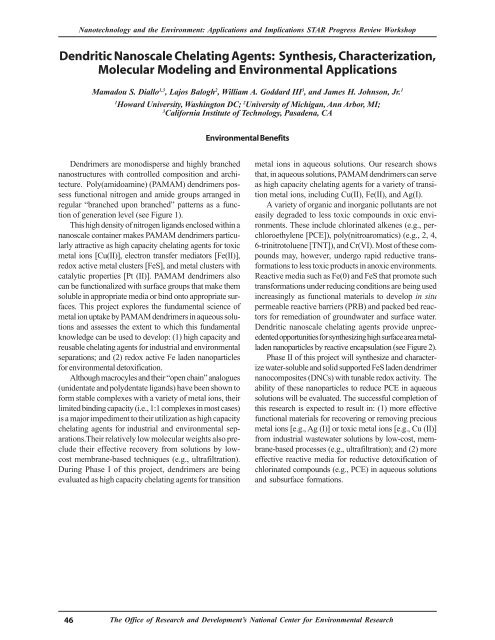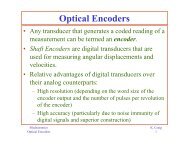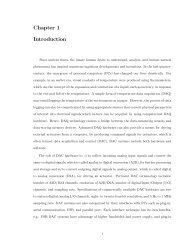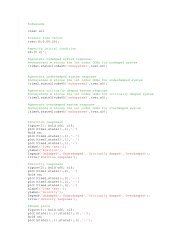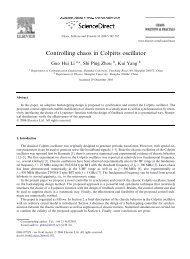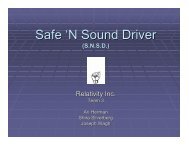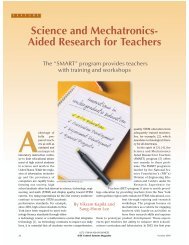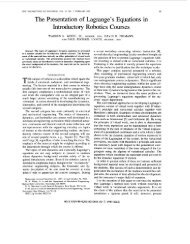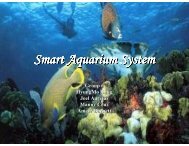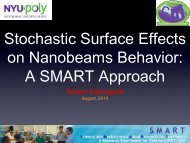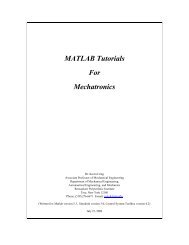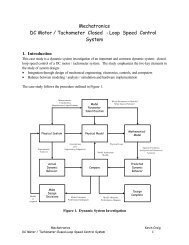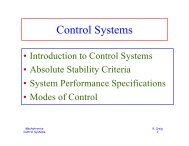EPA Nanotechnology and the Environment ... - Mechatronics
EPA Nanotechnology and the Environment ... - Mechatronics
EPA Nanotechnology and the Environment ... - Mechatronics
Create successful ePaper yourself
Turn your PDF publications into a flip-book with our unique Google optimized e-Paper software.
<strong>Nanotechnology</strong> <strong>and</strong> <strong>the</strong> <strong>Environment</strong>: Applications <strong>and</strong> Implications STAR Progress Review Workshop<br />
Dendritic Nanoscale Chelating Agents: Syn<strong>the</strong>sis, Characterization,<br />
Molecular Modeling <strong>and</strong> <strong>Environment</strong>al Applications<br />
Mamadou S. Diallo 1,3 , Lajos Balogh 2 , William A. Goddard III 3 , <strong>and</strong> James H. Johnson, Jr. 1<br />
1<br />
Howard University, Washington DC; 2 University of Michigan, Ann Arbor, MI;<br />
3<br />
California Institute of Technology, Pasadena, CA<br />
<strong>Environment</strong>al Benefits<br />
Dendrimers are monodisperse <strong>and</strong> highly branched<br />
nanostructures with controlled composition <strong>and</strong> architecture.<br />
Poly(amidoamine) (PAMAM) dendrimers possess<br />
functional nitrogen <strong>and</strong> amide groups arranged in<br />
regular “branched upon branched” patterns as a function<br />
of generation level (see Figure 1).<br />
This high density of nitrogen lig<strong>and</strong>s enclosed within a<br />
nanoscale container makes PAMAM dendrimers particularly<br />
attractive as high capacity chelating agents for toxic<br />
metal ions [Cu(II)], electron transfer mediators [Fe(II)],<br />
redox active metal clusters [FeS], <strong>and</strong> metal clusters with<br />
catalytic properties [Pt (II)]. PAMAM dendrimers also<br />
can be functionalized with surface groups that make <strong>the</strong>m<br />
soluble in appropriate media or bind onto appropriate surfaces.<br />
This project explores <strong>the</strong> fundamental science of<br />
metal ion uptake by PAMAM dendrimers in aqueous solutions<br />
<strong>and</strong> assesses <strong>the</strong> extent to which this fundamental<br />
knowledge can be used to develop: (1) high capacity <strong>and</strong><br />
reusable chelating agents for industrial <strong>and</strong> environmental<br />
separations; <strong>and</strong> (2) redox active Fe laden nanoparticles<br />
for environmental detoxification.<br />
Although macrocyles <strong>and</strong> <strong>the</strong>ir “open chain” analogues<br />
(unidentate <strong>and</strong> polydentate lig<strong>and</strong>s) have been shown to<br />
form stable complexes with a variety of metal ions, <strong>the</strong>ir<br />
limited binding capacity (i.e., 1:1 complexes in most cases)<br />
is a major impediment to <strong>the</strong>ir utilization as high capacity<br />
chelating agents for industrial <strong>and</strong> environmental separations.Their<br />
relatively low molecular weights also preclude<br />
<strong>the</strong>ir effective recovery from solutions by lowcost<br />
membrane-based techniques (e.g., ultrafiltration).<br />
During Phase I of this project, dendrimers are being<br />
evaluated as high capacity chelating agents for transition<br />
metal ions in aqueous solutions. Our research shows<br />
that, in aqueous solutions, PAMAM dendrimers can serve<br />
as high capacity chelating agents for a variety of transition<br />
metal ions, including Cu(II), Fe(II), <strong>and</strong> Ag(I).<br />
A variety of organic <strong>and</strong> inorganic pollutants are not<br />
easily degraded to less toxic compounds in oxic environments.<br />
These include chlorinated alkenes (e.g., perchloroethylene<br />
[PCE]), poly(nitroaromatics) (e.g., 2, 4,<br />
6-trinitrotoluene [TNT]), <strong>and</strong> Cr(VI). Most of <strong>the</strong>se compounds<br />
may, however, undergo rapid reductive transformations<br />
to less toxic products in anoxic environments.<br />
Reactive media such as Fe(0) <strong>and</strong> FeS that promote such<br />
transformations under reducing conditions are being used<br />
increasingly as functional materials to develop in situ<br />
permeable reactive barriers (PRB) <strong>and</strong> packed bed reactors<br />
for remediation of groundwater <strong>and</strong> surface water.<br />
Dendritic nanoscale chelating agents provide unprecedented<br />
opportunities for syn<strong>the</strong>sizing high surface area metalladen<br />
nanoparticles by reactive encapsulation (see Figure 2).<br />
Phase II of this project will syn<strong>the</strong>size <strong>and</strong> characterize<br />
water-soluble <strong>and</strong> solid supported FeS laden dendrimer<br />
nanocomposites (DNCs) with tunable redox activity. The<br />
ability of <strong>the</strong>se nanoparticles to reduce PCE in aqueous<br />
solutions will be evaluated. The successful completion of<br />
this research is expected to result in: (1) more effective<br />
functional materials for recovering or removing precious<br />
metal ions [e.g., Ag (I)] or toxic metal ions [e.g., Cu (II)]<br />
from industrial wastewater solutions by low-cost, membrane-based<br />
processes (e.g., ultrafiltration); <strong>and</strong> (2) more<br />
effective reactive media for reductive detoxification of<br />
chlorinated compounds (e.g., PCE) in aqueous solutions<br />
<strong>and</strong> subsurface formations.<br />
46<br />
The Office of Research <strong>and</strong> Development’s National Center for <strong>Environment</strong>al Research


